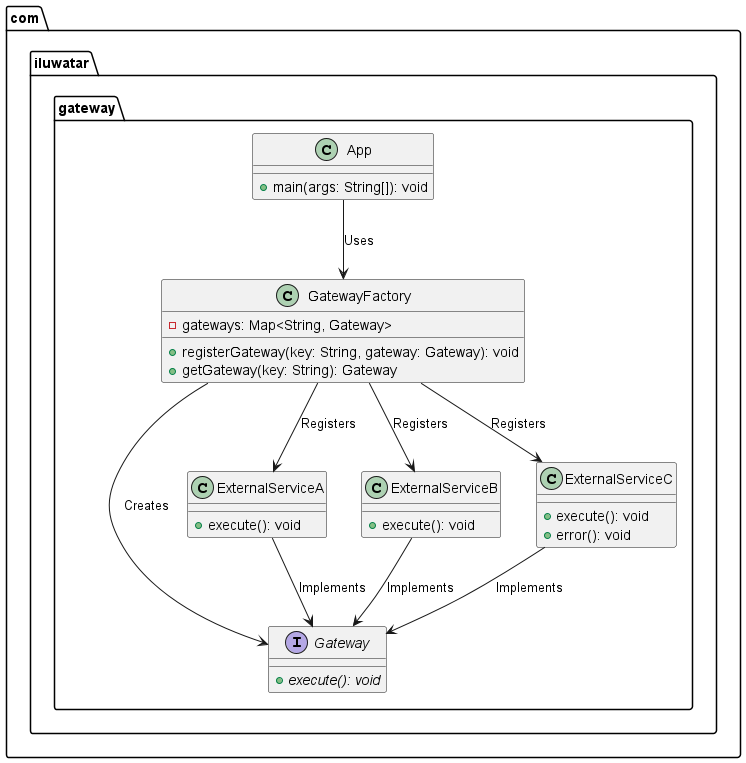Gateway
Intent
Provide a interface to access a set of external systems or functionalities. Gateway provides a simple uniform view of
external resources to the internals of an application.
Explanation
Real-world example
Gateway acts like a real front gate of a certain city. The people inside the city are called
internal system, and different outside cities are called external services. The gateway is here
to provide access for internal system to different external services.
In plain words
Gateway can provide an interface which lets internal system to utilize external service.
Wikipedia says
A server that acts as an API front-end, receives API requests, enforces throttling and security
policies, passes requests to the back-end service and then passes the response back to the requester.
Programmatic Example
The main class in our example is the ExternalService that contains items.
class ExternalServiceA implements Gateway {
@Override
public void execute() throws Exception {
LOGGER.info("Executing Service A");
// Simulate a time-consuming task
Thread.sleep(1000);
}
}
/**
* ExternalServiceB is one of external services.
*/
class ExternalServiceB implements Gateway {
@Override
public void execute() throws Exception {
LOGGER.info("Executing Service B");
// Simulate a time-consuming task
Thread.sleep(1000);
}
}
/**
* ExternalServiceC is one of external services.
*/
class ExternalServiceC implements Gateway {
@Override
public void execute() throws Exception {
LOGGER.info("Executing Service C");
// Simulate a time-consuming task
Thread.sleep(1000);
}
public void error() throws Exception {
// Simulate an exception
throw new RuntimeException("Service C encountered an error");
}
}
To operate these external services, Here's the App class:
public class App {
/**
* Simulate an application calling external services.
*/
public static void main(String[] args) throws Exception {
GatewayFactory gatewayFactory = new GatewayFactory();
// Register different gateways
gatewayFactory.registerGateway("ServiceA", new ExternalServiceA());
gatewayFactory.registerGateway("ServiceB", new ExternalServiceB());
gatewayFactory.registerGateway("ServiceC", new ExternalServiceC());
// Use an executor service for asynchronous execution
Gateway serviceA = gatewayFactory.getGateway("ServiceA");
Gateway serviceB = gatewayFactory.getGateway("ServiceB");
Gateway serviceC = gatewayFactory.getGateway("ServiceC");
// Execute external services
try {
serviceA.execute();
serviceB.execute();
serviceC.execute();
} catch (ThreadDeath e) {
LOGGER.info("Interrupted!" + e);
throw e;
}
}
}
The Gateway interface is extremely simple.
interface Gateway {
void execute() throws Exception;
}
Program output:
Executing Service A
Executing Service B
Executing Service C
Class diagram

Applicability
Use the Gateway pattern
- To access an aggregate object's contents without exposing its internal representation.
- To integration with multiple external services or APIs.
- To provide a uniform interface for traversing different aggregate structures.